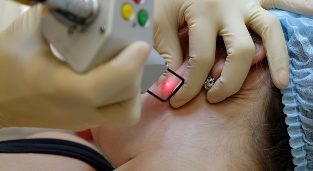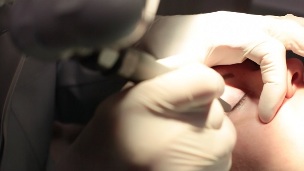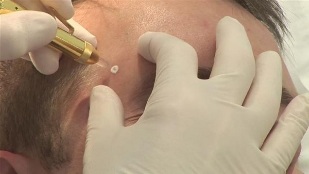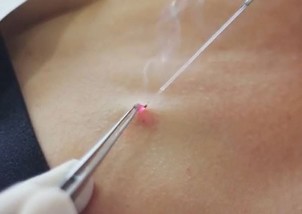
Laser neoplasm removal is a very common and effective procedure that helps to remove unwanted growths. This is a relatively new method that appeared in the medical arsenal not so long ago, but has already managed to prove its superiority over other methods of removal. Laser destruction was preceded by removal using liquid nitrogen, electricity, or a scalpel. All of this can cause significant discomfort to the patient, while laser removal shows good results with painless intervention.
Why you should remove
Papillomas, which are growths of various shapes and sizes, are usually benign neoplasms. They are localized to the mucous membranes of the holder or his skin. The main reason for their appearance is the action of human papillomavirus, in most cases sexually transmitted.
Removing these losses accomplishes several tasks at once:
- Aesthetic correction.A growing patient may be uncomfortable with being overly cared for by others. Because of this, a person may feel vulnerable and uncomfortable, even if growth does not pose a threat to him.
- Damage prevention.If the growth is in a traumatic area where the patient is constantly touching it, this may cause the rash to separate. In addition, when trying to cover the papilloma with clothing, there may be a problem such as rubbing the affected area. It is fraught with papilloma damage and possible subsequent infection. Injury can lead to the penetration of microbes, which can lead to wound inflammation. If this happens, the damaged area should be treated with peroxide and you should immediately go to the clinic to remove the remaining part of the papilloma.
- Reduce cancer risk.Although the growths are benign in nature, there is a variety of manifestations such as warts. They are usually located in intimate areas and pose a great danger in terms of cancer development. To prevent the disease, all warts should be removed.
Do not remove the growth on your own. Any attempt to attach the papilloma with a thread, comb, or apply any kind of chemical to it can worsen its condition.
Advantages of the procedure
Laser destruction has several advantages over other methods of removal.This includes:
- Guaranteed result.Thanks to the laser effect, the growth is completely dissolved, leaving nothing even in the deep subcutaneous layers. The device can penetrate deep enough to clear all traces of the presence of a neoplasm.
- Painless.Laser exposure gives the patient minimal pain. If pre-anesthesia with local anesthetics is added to the procedure, there is no pain at all.
- Procedure speed. Removal of papillomas with a laser takes 2-5 minutes per element.
- Non-invasiveness.The laser beam is in a strictly limited area and does not extend beyond it. In this case, more than one part of the laser does not touch the procedure site. This is very important as this method helps reduce the risk of infection and gives a high guarantee of sterility.
- There are no postoperative scars.If the job is done correctly, there should be no traces of laser action at the site of exposure. This is caused by the affected tissue being completely evaporated and then replaced by new, intact skin.
- A bloodless way to delete.The laser beam heats the blood-supplying capillaries, quickly sealing their walls. As a result, the bleeding stops after the operation and does not resume.
- Suitable for different parts of the body.Not all removal methods can be applied to all parts of the body. Particularly sensitive are intimate areas, eyelids, etc. Sh. Laser destruction does a good job of developing in such places because of the accuracy of the laser beam.
All of these factors increase laser removal from one of the most sought after procedures.
Contraindications
The list of contraindications to this procedure is not longer than other methods of destruction.Among the bans on laser removal:
- Diabetes mellitus;
- Oncology;
- exacerbation of chronic diseases;
- epilepsy;
- Diseases related to endocrine system problems;
- poor blood clotting;
- HIV or AIDS;
- Acute inflammatory diseases.
In addition, patients who have recently had the flu or acute respiratory infections should also delay the procedure for some time.
Description of the procedure
Before any procedure to remove the growths, the doctor will disinfect the surgical site. In some cases, a local anesthetic is used. Ointment or spray is usually used for this. After using the anesthetic, 2-3 minutes pass and the removal process begins.

The laser beam is directed at the affected area and, as it turned out, causes unwanted growth. At this point, the laser evaporates the contents of the cells, removing each layer of affected tissue. This happens not only in open areas but in easily accessible places. The procedure for removing a papilloma, for example, on the eyelid, is the same. The only nuance of this place is that a special cooling method is used for the patient to prevent pain and burns at this sensitive point.
Neoplasms are opened in intimate areas according to the same principle. But here the doctor usually uses the anesthetic injection as an anesthetic, increasing the injection from different sides.
The moment of insertion of the needle may be somewhat painful, but after a couple of minutes the sensitivity in the affected area disappears completely and subsequent manipulations are completely painless.
The affected area becomes a small wound without blood. During destruction it is disinfected due to the work of the laser. After removing the accumulation, the doctor treats the affected area with potassium permanganate.
After the procedure, the patient may have slight redness, itching, or slight pain at the site of papilloma removal.
This reaction is considered normal because despite the non-invasive procedure, there was an interference with the integrity of the skin during the operation.All discomfort should disappear completely 2-4 days after the procedure.
A dry crust later appears on the wound. There is already a layer of healthy skin under it, so its protective membrane can not be destroyed until it itself falls off. Otherwise, the scar may remain on the skin and the healing process itself may take longer.
Results
Complications after laser destruction are rare. Typically, their presence is associated with diseases that the patient already has that he or she did not cure before the procedure. So, for example, if a patient has had skin inflammation, it may contribute to the formation of pigmentation. If the skin itself is very sensitive, there may be a slight redness associated with the burn. During a high allergic reaction, swelling may occur at the site of exposure.
To rule out any side effects it is necessary to consult a doctor before performing laser destruction.
Care after the procedure
After removing the accumulation, the patient should follow the following rules:
- Do not allow water on the wound for 2-3 days;
- Refrain from visiting saunas, baths and swimming pools;
- Do not wipe the affected area with a towel;
- Do not apply adhesive plaster to the wound;
- Do not treat papilloma removal site with scrubs, alcohol-based lotions;
- Avoid exposure to ultraviolet rays.
It is necessary to carry out antiseptic treatment of the wound several times a day. This should be done before the bark separates. This treatment should prevent infection and help speed up the full recovery time.You can take iodine or potassium permanganate solution to treat the affected area.
The removal site can be treated with anti-inflammatory ointments.
Their action is aimed at accelerating tissue regeneration, removing inflammation and swelling. It is best to consult your doctor before choosing a particular remedy.
Which method is better
Laser removal is not the only method to deal with unwanted growth. There are other ways to distinguish between:

Cryodestruction.
Based on the removal of papillomas with liquid nitrogen. Due to the impact of low temperatures, the accumulation begins to break down and eventually disappears altogether. The method is effective but has several disadvantages. Including the inability to fully control the depth of action of nitrogen. The substance can penetrate very deeply, touch a healthy area, or vice versa, affect only superficially, so as not to affect all layers of the localization of the accumulation.
In addition, this method is characterized by:
Possibility of- postoperative scars;
- painful sensations;
- Guarantee the result after the first procedure.
Thus, laser destruction is more effective than cryodestruction. Laser removal is less painful and is likely to guarantee the desired result.
Radio wave removal.
This method of destruction is carried out using a special device that acts on the papilloma by means of radio waves. This facilitates the excision of the accumulation due to the point effect of the radio knife. The accuracy of the procedure is very high, so as not to affect the surrounding tissues. However, the risk of burns or infection is very low.
This method is suitable for removing small benign lesions. This is very effective, which makes it popular as a laser destroyer. Both methods are considered to be modern approaches to papilloma removal and are equally well used in medicine.

Electrocoagulation.
This method is based on the action of high-frequency electric current, which acts on the papilloma directly at the site of injury. Electrocoagulation is now considered as a conventional but outdated method. This method allows you to prevent bleeding after burning the papilloma by burning the vessel.
However, when using high frequency power, patients experience pain that occurs even after anesthesia. This has led some patients to opt for electrocautery to opt for laser removal as a more advanced and painless method.
Estimated value
The price range depends not only on the region and clinic where the removal takes place, but also on the number, size and location of the removed formations.
Many clinics offer discounts on most new growths: The more patients there are, the cheaper it will be to remove one growth.
Getting rid of the genital area can be significantly more expensive than getting rid of other parts of the body. Moreover, not all clinics provide such services due to the complexity of such manipulation.














































































